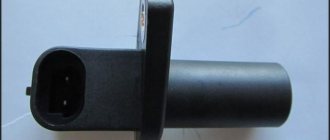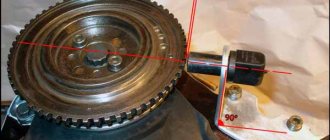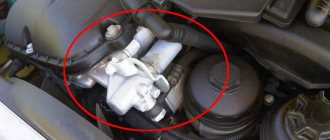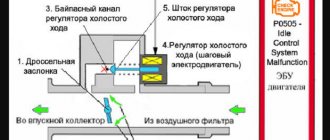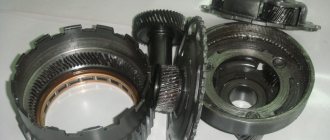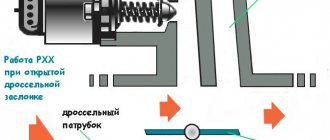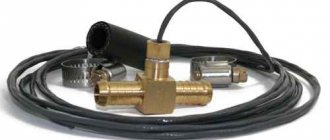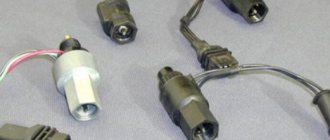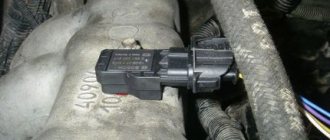02 March 2017 Lada.Online 49 753 4
DPKV (crankshaft position sensor), also known as TDC sensor (top dead center sensor) is the only sensor of the engine management system, if which breaks down, the engine will definitely not start. This sensor has no mechanical moving parts, so it rarely fails. Most often, corrosion-damaged wiring is to blame for its failure.
DPKV - what kind of sensor is it, why is it needed on Priora and why the engine does not start
From the brief introduction it is clear that the crankshaft sensor is the most important structural element on a car, without which the engine cannot operate. The main purpose of the device is to transmit a signal to the computer about the position of the crankshaft at an appropriate period of time. Reading information about the position of the crankshaft allows the control unit to decide on sending signals for fuel injection and ignition in the corresponding engine cylinders.
In addition to information about the position of the crankshaft, the sensor also informs the control unit about its rotation speed. The frequency at which the crankshaft rotates is displayed on the car's control panel, for which a tachometer is provided. The electronic method of measuring the crankshaft rotation speed is highly accurate. Based on the readings of this sensor, the following actions occur:
- The fuel injection time is set through the injectors in the corresponding cylinders.
- The ignition timing is determined, which allows fuel assemblies to be burned more efficiently and effectively.
- The efficiency of the internal combustion engine operation is assessed.
- Information about the crankshaft rotation speed is transmitted to the instrument panel, which is necessary for the driver.
By means of DPKV, the moment of passage of the pistons at the top and bottom dead centers is determined. Based on this information, engine operation is adjusted. Without such a device, not a single ECU works, so if it malfunctions, you will need to immediately resort to finding out the causes of the failure and eliminating them.
This is interesting! A car uses a large number of different sensors. In addition, many of them respond to or influence the operation of the motor. However, the failure of any sensor, except for the DPKV, will not entail such consequences as the inability to start the engine. Only the crankshaft position sensor can cause the engine on a Priora to not start.
Camshaft and crankshaft sensors for Lada Kalina 8 valves description and replacement nuances
The camshaft sensor Kalina 8 valves becomes unusable from time to time. This can happen for various reasons, but the result is the same - the part needs to be replaced. The situation is similar with the crankshaft position sensor. You will learn in the article how to dismantle old and install new elements of a car of this type.
Phase sensor (camshaft position)
You will find this part on the cylinder head on the left side. The operating principle is quite simple. There is a special pin on the camshaft itself. When it passes by the sensor, but sends a signal to it. This moment corresponds to compression of the piston of the first cylinder.
The controller determines the camshaft angle. This is important information for machine systems and sensor failure has certain consequences. The information is sent to the vehicle's ECU, which uses it to control the ignition and fuel supply to each cylinder.
In what situations is replacement required?
If this part fails, you will see a “Check” indicator on the vehicle’s instrument panel. This is how the ECU signals the driver that the engine needs to be checked. At the same time, the fuel supply pattern changes - it goes to all cylinders simultaneously and, as a result, consumption increases.
The cause of the breakdown may be mechanical damage, as well as other things. There is no point in trying to repair the old unit itself - it costs little and you will waste more nerves and time.
In the video below you will find instructions for replacing this part (the author of the video is Alexandr V).
Replacement instructions
To replace the camshaft sensor, you only need a "10" key. It is better to use a socket with a collar or a ratchet. It will be inconvenient to work with a regular key, although it is still quite possible.
The dismantling and installation procedure is as follows:
- First, disconnect the block with wires by pressing the latch and slightly pulling it up;
- now, using the key, unscrew the part itself;
- it can be pulled out by slightly pulling towards the windshield;
- installation is carried out in the reverse order of steps.
There are no difficulties in this process, but be careful not to damage both the block with wires and the connector for the controller itself on the cylinder block.
Crankshaft position sensor
Although this controller rarely fails, its failure can lead to the most unpleasant consequences. You may simply end up in the middle of the road with no way to continue driving.
This element is installed on the oil pump cover. The DPKV transmits information to the ECU so that it can synchronize the fuel supply. Inductive type sensor. As mentioned above, it rarely fails, but this becomes a big problem.
In what situations is replacement required?
If this DPKV is completely out of order, you will not be able to start the engine at all.
But even if it just works intermittently, this can be recognized by a number of signs:
- poor engine starting;
- unstable work;
- power reduction;
- detonation with increasing load.
If you notice such signs and there are no other reasons for them, change the sensor. You can check it by testing the resistance of the windings. If the ohmmeter readings differ from 550-570, then the part is faulty. Fortunately, it costs little and replacement can be done very quickly.
Replacement instructions
To replace this part, you will again need a "10" key and nothing else.
- Turn off the ignition. Then disconnect the wire block by pressing the latch.
- Now, using a wrench, unscrew the fastening bolt.
- All that remains is to remove the old DPKV and install the new one in the reverse order.
Characteristic signs of a faulty DPKV on a Priora: how to understand that the crankshaft sensor has failed
On cars, the crankshaft sensor rarely fails, but on the Priora such an element is one of many diseases. Failure of such a device can occur for various reasons. This can be as contamination of the working surface of the product, which leads to inaccuracy in its functioning. This problem can be easily solved - you need to remove the sensor and remove all contaminants. Typical signs that there are problems with the crankshaft sensor on the Priora are the following:
- A significant decrease in engine power, which is associated with the ECU switching to emergency mode (when the mixture is prepared according to average parameters).
- When the number of revolutions increases, detonation loads arise, which negatively affect the life of the CPG.
- Floating speed at idle.
- Difficulty starting the engine. If the sensor is working properly, but it is dirty or moisture gets into the contacts, then its functioning will be incorrect. In this case, it will be possible to start the engine, but, as a rule, this will happen 3-4 times.
- Dips appear during acceleration.
The manifestation of the above symptoms should force the vehicle owner to resort to identifying the cause of the malfunction and eliminating it. Otherwise, at one point the crankshaft sensor will completely fail, and a characteristic sign of this phenomenon will be the inability to start the engine. You can determine the malfunction of the DPKV on a Priora by displaying errors P0335, P0336 and P0337 on the on-board computer
. Error P0335 indicates a circuit malfunction, P0336 indicates that the device indicators are outside the permissible values, and P0337 indicates a short circuit of the DPKV to ground.
This is interesting! The DPKV cannot be repaired, therefore, if it malfunctions, it must be replaced. However, you should not rush to dispose of the device, since you can first verify that it is faulty by carrying out testing procedures.
Methods for checking the crankshaft sensor
If there are signs of a malfunction of the crankshaft position sensor, then first of all you should check the errors recorded in the memory. Using the received codes, you can decipher problems with the DPKV.
You can find signs of a malfunctioning crankshaft sensor by visual inspection. There should be no dents, cracks or other mechanical defects on the body. If any defects are detected, the DPKV requires replacement, since it has low maintainability.
You can check the crankshaft sensor with an ohmmeter or multimeter. To do this, you need to connect the probes to the DPKV contacts. The result obtained should be in the range from 500 to 750 Ohms. With a lower value there is a risk of interturn short circuit. Too much resistance indicates a broken winding in the sensor.
If you have a multimeter that can measure inductance, it should be measured in the sensor. In normal condition, the winding should show a result of 200 to 400 mH. If there is a significant deviation in the inductance of the DPKV, it must be replaced.
The most accurate test is using an oscilloscope. Based on the shape and absence of gaps in the graph, you can determine the serviceability of the sensor.
How to check DPKV on Priora yourself
You can check the serviceability of the crankshaft sensor on a Priora with your own hands. First you need to dismantle it. Then carry out a visual inspection. Remove all excess dirt, and especially from the end side of the device (not only dirt, but also metal shavings accumulate there). After this, you can continue the verification procedure:
- Check the integrity of the winding
. There is a winding inside the sensor, so first we check its integrity. To do this, switch the multimeter to the “testing” mode and touch the leads with the probes. If there is a characteristic sound from the device, then everything is in order with the winding. - Measure the winding resistance.
To do this, switch the resistance measurement mode on the multimeter (up to 2000 Ohms), and touch the output contacts of the device with the probes. The approximate resistance value is 500-700 Ohms. Anything above or below these limits indicates a device malfunction. - Measuring voltage at the sensor terminals.
If previous measurements have shown that the product is in good condition, then it would not hurt to check the integrity of the steel core. This can be done using a multimeter. It is necessary to check whether voltage is induced in the winding when touching the steel core of a metal part. To do this, we connect the probes to the sensor terminals, and set the multimeter to the DC voltage measurement mode (the minimum value on the device is 200 mV). Next, we bring a metal part to the end side of the sensor and look at the multimeter readings. A change in the device readings indicates that the sensor is working.
These are the main ways to check the crankshaft position sensor on a Priora. Do not forget that the Priora uses an inductive sensor, not a semiconductor one (it is checked in other ways). Depending on the type of device, the verification method differs.
This is interesting! It is very important to understand that the verification methods described above only allow indirect verification of the serviceability of the product. To make sure the device is working for sure, you need to conduct computer diagnostics or check the DPKV on an oscilloscope. Such testing methods will help ensure not only that the product is working, but also that it is functioning correctly.
If, after checking, you put the sensor in place, but the car does not start or there are interruptions in the operation of the engine, then it is also important to check the condition of the wires and chips that are connected to the element. A multimeter, which can be used to test the wires, will also help in this matter. It is necessary to find the wire leads from the sensor on the ECU unit and check the wiring. It is also important to understand that there is no voltage on the DPKV chip, so do not try to connect the multimeter probes to detect voltage there.
Malfunction of the Priora crankshaft sensor (DC)
Since 2004, the Russian manufacturer VAZ has completely abandoned the production of cars with engines operating with a carburetor system. A switch was made to an electronic engine control system, or ECM (Electronic Engine Control System).
In common parlance, drivers call this option a car with an injector. Although this is not entirely true. The injector, to be precise, in this system is a fuel injection nozzle, and the basis of control here is the ECU (Electronic Control Unit).
Simply put, a computer and sensors, including the crankshaft.
About how the esud system works, details
So, the modern “Priora” is no longer a “penny” of the 70s, or even a “nine” of the 90s. This is a completely modern car, most of the functions and malfunctions of which are controlled and monitored by a computer. Under the control of various ECUs are:
- engine control;
- power steering;
- anti-theft system;
- anti-lock wheels;
- electrical package;
- climate control.
Where is the crankshaft sensor installed on Priora?
It is important for all Priora car owners to know where the DPKV is located. After all, the need to check or replace it may arise at any time, and therefore it is better to figure out where the sensor is located in advance. It is also recommended to purchase a new element and carry it with you in the glove compartment so that an unpleasant situation does not overtake you away from home.
On a Priora, the crankshaft position sensor is located next to the oil filter on the oil pump cover.
You can get to the device both from the engine compartment and from the inspection hole. The photo below shows where the DPKV is located on Priora.
Knowing its location is necessary in order to be able to quickly dismantle it for the purpose of inspection or replacement. When purchasing a new sensor, it is recommended to rewrite the designations on the standard product.
Where is the Lada Priora crankshaft sensor located and faulty?
The crankshaft sensor is responsible for uniform fuel injection and supplying an impulse to ignite the combustible mixture. In other words, we can say that with its help the controller determines when and into which cylinder fuel needs to be supplied.
Where is DPKV located?
The engine crankshaft has a toothed drive disk; it is combined with the generator drive. At a distance of approximately 1 mm from the top of its tooth, on the oil pump cover, a Lada Priora crankshaft sensor is attached.
Where is the fuse box on the Lada Priora
The master disk has only 58 teeth, with an indent of 6 degrees, as well as a gap of two missing teeth - this is how synchronization is done. In order to place the crankshaft at a point of 114 degrees to the uppermost point of cylinders 1 and 4, combine the middle of the first tooth after the gap with the DPKV axis.
The crankshaft wiring is protected from outside interference by a kind of screen that is connected to the vehicle's ground.
Incorrect operation of the circuit can cause the motor to stop, error codes to be recorded in the controller’s memory and the alarm to be activated.
The crankshaft sensor circuits are checked after the ignition is turned off and the pads are disconnected from the controller and the sensor itself. If the DPKV circuit is in good working order, the installation is high-quality, but the error code remains, which indicates incorrect operation of the part, the DPKV needs to be changed.
Where is the Lada Priora oil pressure sensor located and faulty?
Replacing the crankshaft sensor
Let's take a closer look at the process of removing a part:
- the ignition must be turned off;
- the wire block must be disconnected;
- Using a 10mm wrench, unscrew the bolt that secures the sensor to the oil supply cover;
- we take out the faulty sensor.
After the faulty part is removed, install a new one:
- install a new sensor;
- we wrap the bolt and tighten it until it is completely secured;
- connect the wiring to the part itself.
We identify signs of malfunction
If the crankshaft position sensor is completely out of order, it will not allow the car to start normally. In other cases, incorrect operation of the part is detected by the following actions:
- The engine starts intermittently and is not stable.
- Engine operation will be unstable.
- Motor power is significantly reduced.
- If the load is increased, detonation appears.
You can check the crankshaft sensor using the insulation resistance test. If the numbers on the ohmmeter differ from the readings of 550-570 Ohms, it means that the DPKV has failed. In the case where the DPKV error has not been cancelled, therefore, it is necessary to clean the part from dirt and check the integrity of the wiring and connections. It is not possible to repair the DPKV, it can only be replaced.
For Soviet car models, getting the necessary part to replace it is not too difficult. For example, Priora DPKV can be purchased at your nearest auto store, and instructions for replacing it can be easily found on the Internet. If you don’t dare to do this work yourself, then the nearest service station will do it for you in the shortest possible time and for little money.
How to remove and replace DPKV on a Priora
The process of dismantling the DPKV on Priora is not complicated, and everything takes no more than five minutes of time. Features of removing the crankshaft position sensor on a Priora:
- Disconnect the plug by first squeezing the tab.
- Unscrew the fastening bolt using a 10mm socket and a ratchet.
- Remove the sensor and install a new element in its place, after making sure that the removed product is faulty.
The process of removing DPKV on Priora is described in detail in the video below.
It is important to know that sensors for cars of the VAZ family are suitable for Priora. They have article number 191.3847 and cost about 200-300 rubles. In conclusion, it is worth noting that knowing the operating principle of the crankshaft sensor, as well as the main signs of its malfunction, it will not be difficult to carry out the necessary manipulations to eliminate them.
How to check the Priora crankshaft sensor: three ways
First method : checking the resistance with an ohmmeter. The advantage of this method is that it is the simplest, easiest, and does not require any specific knowledge. In addition, to check the resistance of the DPKV you need to spend a minimum of time. The disadvantage is that this method does not provide a 100% guarantee of the accuracy of the results obtained. In general, it’s up to you to decide how to check the sensor - quickly, but with the possibility of making a mistake, or spend a lot of effort and time, but be confident in the reliability of the result.
So, to do this you need to do the following:
The optimal value of coil resistance is considered to be 500 - 750 Ohms. If the measurement showed different data - significantly larger or smaller, then everything is not in order with the device. But you shouldn’t be critical of the results obtained.
Second method: measuring the inductance of the coil. A coil is built into the DPKV body; any coil has inductance. Therefore, it is possible to measure the value of this parameter and draw a conclusion whether the sensor is suitable or not. Difficulty - not all multimeters are capable of measuring inductance, so you may have to look for a special device.
In general, we measure the inductance; normally, the value should be in the range from 200 to 400 mH. In contrast to resistance, the indicator may differ (but only slightly). If the difference in values reaches 10% or more, change the Priora crankshaft sensor.
Third method : the most accurate. True, this requires an oscilloscope and appropriate software. We connect the probes of the device to the sensor terminals, launch the software, pick up a metal object and hold it near the DPKV. The sensor must detect the movement of an object, as evidenced by changes in the oscillogram. If this does not happen, replace the DPKV.
Good afternoon. In today's article, I have collected for you all the signs of a faulty crankshaft position sensor.
Traditionally for our site, the article contains many photos and video materials.
What is the crankshaft position sensor for and how does it work?
The crankshaft position sensor is used to determine the angle of rotation of the crankshaft at a given time.
This is the only sensor without which the engine will not work.
It looks like this:
If possible, you should take this sensor with you - it is not expensive, but it is not always on sale, especially in stores in remote areas.


